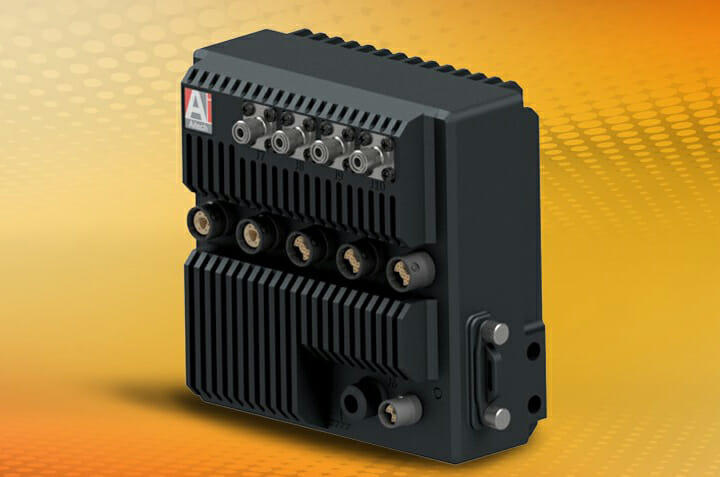~ How embedded computing is driving safety on the battlefield ~
The advancement of military technology in the past 20 years has reshaped the battlefield. From unmanned aerial vehicles (UAVs) for aerial surveillance and air strikes to unmanned ground vehicles (UGVs) for remote reconnaissance, modern warfare is seemingly shifting from primarily ‘boots on the ground’ operations to battlefields being dominated remotely. Here, Martin Frederiksen, managing director of land defence embedded system specialist Recab UK, explains the role embedded computing is playing in the next generation of land military technology.
In 1922, one of the world’s first remote radio-controlled cars was showcased publicly. Reporting on the demonstration in its magazine, the Radio Corporation of America (RCA) stated that “the demonstration showed the war time possibilities of locomotion. Tanks could be loaded with TNT and let loose without a driver over into No Man’s Land”. That same year, American inventor John Hays Hammond Jr installed radio control gear on an obsolete battleship to turn it into a target ship for naval gunnery practice.
The focus on remote military technologies continues to this day, albeit in a substantially more sophisticated way. As military technology has advanced in the past two decades, one consistent objective for defence departments globally has been to reduce casualties in their forces. This focus has spurred developments in UAVs, UGVs and, more recently, in autonomous UGVs (A-UGVs) — remote units that use artificial intelligence (AI) and machine learning (ML) algorithms alongside a range of sensors to operate independently of a human controller.
The computing requirements grow as A-UGVs are responsible for more functions. For example, defence technology company Rheinmetall produces a line of A-UGVs, with its latest Mission Master SP equipped with several reconnaissance technologies and a remote-controlled weapon system. The unit can conduct environment mapping, intel gathering, target tracking and provide supporting fire when necessary. Delivering this and powering the embedded AI is no easy feat, but it is in part made possible by a general-purpose GPU (GPGPU) system from our partner Aitech.
A GPGPU-based system is the best solution for AI applications in the field. GPGPU computing is based on parallel computing architectures that allow the unit to process tens of thousands of data points simultaneously, which is significantly greater than is possible with even multi-core CPU architectures.
To this end, Aitech’s A179 Lightning is an ideal choice for military A-UGV computing. The rugged GPGPU is based on the NVIDIA Jetson Xavier NX module, which features a Volta architecture GPU with 384 CUDA cores and 48 tensor cores. This allows the module to reach 21 tera operations per second (TOPS) INT8, providing ample processing power for AI applications and complex image processing algorithms. This performance is achieved with high energy efficiency.
In addition to the GPU, the A179 Lightning features an NVMe SSD and extensive I/O support. This is all contained with an ultra-small form factor footprint, and the unit is readily compliant with MIL-STD-810H standards. This makes it easier for a military embedded computing specialist such as Recab UK to design and develop embedded systems featuring this GPGPU, streamlining project times while ensuring the highest possible performance.
Working with a specialist such as Recab UK also ensures that the A-UGVs are fitted with the components required to ensure rapid data communication. For example, the video feeds of A-UGVs must be able to be viewed, in real-time, by troops. Achieving this requires a secure low-latency, high availability connection between the mobile unit and a viewing device. This is where rugged Ethernet switches come in.
Ethernet is typically chosen to support the data-intense operation of military technology, with physical and virtual network security considered. Physical security comes in part from the ports available on a device’s Ethernet switch, with most military switches featuring a mix of copper ports for local communication and fibreoptic interfaces for long-distance communication with inherent EM resistance.
The space available in an A-UGV can influence what is possible in terms of Ethernet switches. Where space is at a premium, the compact EPSM-10GX4 managed Ethernet switch module by Diamond Systems provides optimum performance. This compact switch — measuring only 55x84mm — boasts a thicker PCB, extended operating temperature range and MIL-STD-202G compliant shock and vibration resistance. This renders it ideal for rugged vehicle-based Ethernet switching applications.
In terms of connectivity, the EPSM-10GX4 provides 24 1 Gbps copper ports and four 10 Gbps SFI ports. It includes embedded software offering a vast array of features that support layer 2 switching and layer 3 routing, along with VPN, QoS, and other security features. The module is intended to be used with a carrier board that completes the circuit by adding magnetics, transceivers, and I/O connectors. Customers can design their own or choose from two off-the-shelf carriers from Diamond Systems.
Larger A-UGVs with more available space can also choose from a rugged Ethernet switch and router that allows networks to take advantage of time-sensitive networking (TSN) technologies. TSN provides determinism to networks, which is ideal for applications requiring high synchronisation between devices. This determinism enforces advanced quality-of-service policies, while also supporting the merging of real-time, reserved and best-effort traffic in the same network. Here, the Relyum range by SoC-e is an advantageous option.
The RELY-MIL-SWITCH-ROUTER, part of Relyum’s range, features up to 20x 1G copper and up to 6x 1/10G fibreoptic ports. There is also support for different media types and its distribution in the MIL-DTL-38999 connectors, which allow for complete and cost-effective network infrastructures. Relyum equipment also supports multi-layered security, redundant network topologies aiming high-availability communications, as well as edge-computing and time-server functionalities, which help to achieve the strictest requirements in military applications.
Making use of deterministic protocols such as TSN relies on accurate synchronisation between the UGV and other networked systems. Achieving this requires the UGV to be fitted with a GPS/GNSS module that provides precise timing and positioning, in line with the IEEE-802.1AS standard for precision timing protocol (PTP) timing.
Highly accurate synchronisation necessitates the precision of Trimble GNSS modules, which can provide a pulse-per-second accuracy in the nanosecond range. Trimble modules, as provided by Recab UK, also feature advanced security features and protection against jamming and spoofing.
For positioning, A-UGVs will need similarly precise, centimetre-level output to be effective in critical situations. However, A-UGVs will likely enter into building, densely forested areas or other environments where GPS signal may be difficult to guarantee. As such, it could be advantageous to use a module that includes a complementary technology like dead reckoning (DR), such as Trimble’s Aardvark DR+GPS module.
DR provides an estimation of location based on factors including speed, direction and time since last known position. The GPS functionality of the Aardvark provides its own positioning and also ensures the module’s on-board gyro and any connected speed sensors are continuously calibrated for an accurate DR estimation. This ensures a continuous position output, even in challenging GPS environments
The interest in remote-operated military technology has persisted and grown over the past 100 years, transforming from the notion of TNT-loaded radio-controlled cars to the reality of A-UGVs equipped with intel-gathering devices and weapons systems. With the driving force of reducing risk to soldiers, there is no reason to imagine that the focus on unmanned military technology will not persist for a further century. It all depends on having the right embedded systems in place, with the right design and component expertise, to determine how advanced tomorrow’s A-UGVs become.








